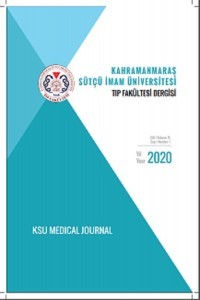Transüretral Cerrahide Spinal Anestezide Ropivakain ve Levobupivakainin Karşılaştırılması
Spinal anestezi, Prostat Transüretral Rezeksiyon (TUR-P), Ropivakain, Levobupivakain
The Comparison of Spinal Ropivacaıne and Levobupivacaine for Transurethral Surgery
Spinal anaesthesia, Transurethral resection of the prostate, Ropivacaine, Levobupivacaine,
___
- 1. Dobson PM, Caldicott LD, Gerrish SP, et al: Changes in hemodynamic variables during transurethral resection of the prostate: Comparison of general and spinal anesthesia. Br J Anesth 1994;72:2672.
- 2. Gravenstein D: Transurethral resection of the prostate (TURP) syndrome: A review of the patophysiology and management. Anesth Analg 1997;84:438
- 3. McLure HA, Rubin AP: Review of local anaesthetic agents. Minerva Anesthesiol. 2005; 71: 59-74.
- 4. McClellan KJ, Faulds D: Ropivacaine: an update of its use in regional anaesthesia. Drugs 2000;60: 1065-1093.
- 5. Foster RH, Markham A. Levobupivacaine: A Review of its Pharmacology and Use as a Local Anaesthetic. Drugs 2000 Mar; 59 (3): 551-579.
- 6. Wahedi W, Nolte H, Klein P: Ropivacaine for spinal anesthesia. A dose –finding study. Anaesthesist. 1996 Aug; 45(8):737-44.
- 7. Sell A, Olkkola K T, Jalonen J, Aantaa R. Minimum effective local anaesthetic dose of isobaric levobupivacaine and ropivacaine administered via a spinal catheter for hip replacement surgery. Br J of Anaest.2005; 94 (2): 239–42
- 12. Chung CC, Choi SR, Yeo KW, Park HS: Hyperbaric Spinal Ropivacaine for Cesarean Delivery: A Comparison to Hyperbaric Bupivacaine. Anesth Analg. 2001;93:157–61
- 9. Cappelleri G, Aldegher G, Danelli G, Marchetti C: Spinal anesthesia with hyperbaric levobupivacaine and ropivacaine for outpatient knee arthroscopy: A prospective, randomized, double-blind study. Anesth Analg. 2005; 101: 77–82
- 10. Casati A, Moizo E, Marchetti C, Vinciguerra F, A prospective randomize, double-blind comporison of unilateral spinal anesthesia with hyperbaric bupivacaine, ropivacaine or levobupivacaine for inguinal herniorrhaphy.Anaesth Analg 2004; 99: 1387-1392
- 11. Heef JW, Veering BT, Anton GL. Spinal Anesthesia with Ropivacaine: A Double-Blind Study on the Efficacy and Safety of 0.5% and 0.75% Solutions in Patients Undergoing Minor Lower Limb Surgery. Anesth Analg 1994;78: 1125-30
- 13. McNamee DA, McClelland AM, Scott S, Milligan KR, Westman L, Gustafson U. Spinal anaesthesia: comparison of plain ropivacaine 5 mg ml(-1) with bupivacaine 5 mg ml (-1) for major orthopaedic suegery. Br J Anaesth 2002;89:702-6
- 14. Glasser C, Marhofer P, Zimpfer G, et al: Levopupivacaine versus racemic Bupivacaine for spinal anaesthesia. Anaesth Anal 2002; 94: 194-198
- 15. Lee YY, Muchhal K, Chan CK: Levobupivacaine versus racemic bupivacaine in spinal anaesthesia for urological surgery. Anaesth Intensive Care. 2003; 31(6): 637-641
- ISSN: 1303-6610
- Yayın Aralığı: Yılda 3 Sayı
- Başlangıç: 2004
- Yayıncı: Kahramanmaraş Sütçü İmam Üniversitesi
Allerjik Rinit Hastalarımızda Alerji Testleri
Leymune PARLAK, Nazan BOZDOĞAN, Ahmet Sait ÇELEBİOĞLU
Hüsnü MARAŞLI, Can ACIPAYAM, Aydın BOZKAYA, Defne Ay TUNCEL, Seda ÇAKMAKLI, Mustafa ÇOBANUŞAĞI, Sadık YURTTUTAN
Öğrenci Gözüyle Özel Bir Hastanedeki Hastaların Düşme Riski ve Hemşirelik Önlemleri
Ebru KARAASLAN, Arzu TUNA, Ayşe SOYLU
Özlem GÜLER, Mustafa YILDIZ, Mehmet Nuri BOZDEMİR, Ahmet KAVAKLI, Adile Ferda DAĞLI, Bilal ÜSTÜNDAĞ
Transüretral Cerrahide Spinal Anestezide Ropivakain ve Levobupivakainin Karşılaştırılması
Bora BİLAL, Özgür YAĞAN, Mahinur Demet ALBAYRAK, Belgin AKAN TUNÇTÜRK, Nermin GÖĞÜŞ
